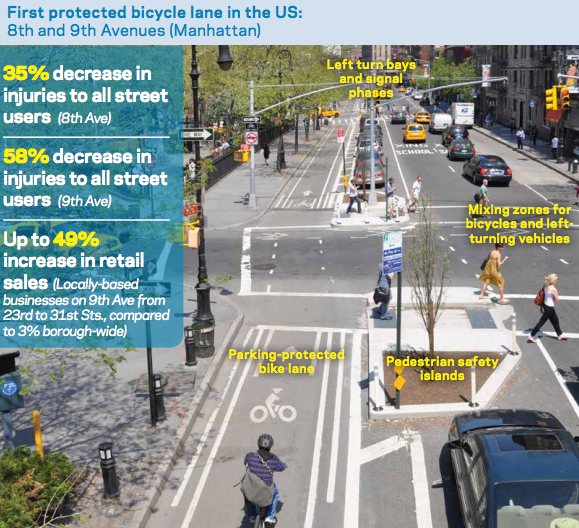Saturday, May 11, 2013
Bikeways are good for business
New York DOT recently completed a study that shows that where protected bikeways are installed, local businesses thrive:
NYC DOT found that protected bikeways had a significant positive impact on local business strength. After the construction of a protected bicycle lane on 9th Avenue, local businesses saw a 49% increase in retail sales. In comparison, local businesses throughout Manhattan only saw a 3% increase in retail sales.
In many ways, these data come as no surprise. We know that when towns invest in bicycle infrastructure, people will ride more — the number of people traveling by bicycle increases when there is infrastructure to make traveling by bike safe and easy.
We also know that people who travel along a street by bicycle have fewer barriers to stopping at a local business than people who travel along the same street by car. It's very easy to hop off a bicycle and find a place to secure the bike; not so with finding parking for an automobile. In fact, a recent study suggest that bicycle riders tend to spend more at local businesses over the course of a month.
Imagine what Maple Ave in Vienna would be like if there were a cycletrack running the length of the Town. As it is, the street is not a pleasant place to walk or bike. The sidewalks are narrow and many businesses have turned their backs to the street and have entrances in the rear. In Tysons, Route 7 and Route 123 would be completely different, more welcoming places with cycletracks or other protected bikeways. Would motorists go any slower than they do now during rush hour? Probably not. Would speeds be slower during other times? Probably yes.In many ways, these data come as no surprise. We know that when towns invest in bicycle infrastructure, people will ride more — the number of people traveling by bicycle increases when there is infrastructure to make traveling by bike safe and easy.
We also know that people who travel along a street by bicycle have fewer barriers to stopping at a local business than people who travel along the same street by car. It's very easy to hop off a bicycle and find a place to secure the bike; not so with finding parking for an automobile. In fact, a recent study suggest that bicycle riders tend to spend more at local businesses over the course of a month.
It will be really interesting to see what effect bike sharing will have on New York.
City officials say the nation's largest bike-sharing system will begin sometime this month with 6,000 bikes at 330 stations in Manhattan and parts of Brooklyn, with plans to expand eventually to 10,000 bikes and 600 docking stations in Manhattan, Brooklyn and Queens.
"When you talk about scale, no other U.S. city comes close," says Jon Orcutt, policy director at the city's Department of Transportation, which is overseeing the launch of the program.
Officials hope the privately funded bike-sharing program, dubbed Citi Bike after a $41 million sponsorship from Citibank and an additional $6.5 million from MasterCard, will add riders to the more than 700 miles of bike lanes throughout New York and will be used by one-way commuters and round-trip tourists alike.
"When you talk about scale, no other U.S. city comes close," says Jon Orcutt, policy director at the city's Department of Transportation, which is overseeing the launch of the program.
Officials hope the privately funded bike-sharing program, dubbed Citi Bike after a $41 million sponsorship from Citibank and an additional $6.5 million from MasterCard, will add riders to the more than 700 miles of bike lanes throughout New York and will be used by one-way commuters and round-trip tourists alike.
Labels: bike share, cycle track, new york city
Comments:





Post a Comment